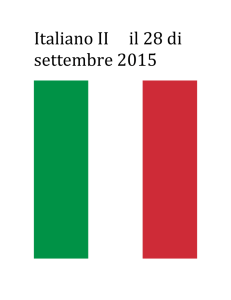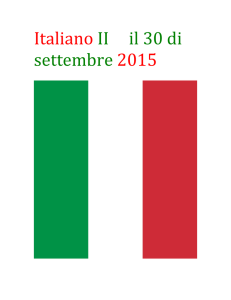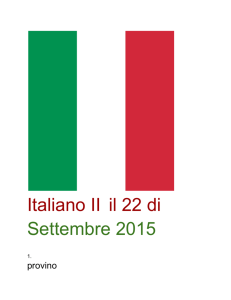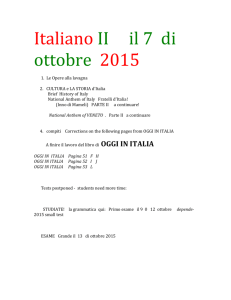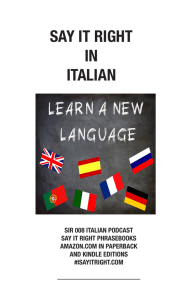Adjectives in Italian
advertisement
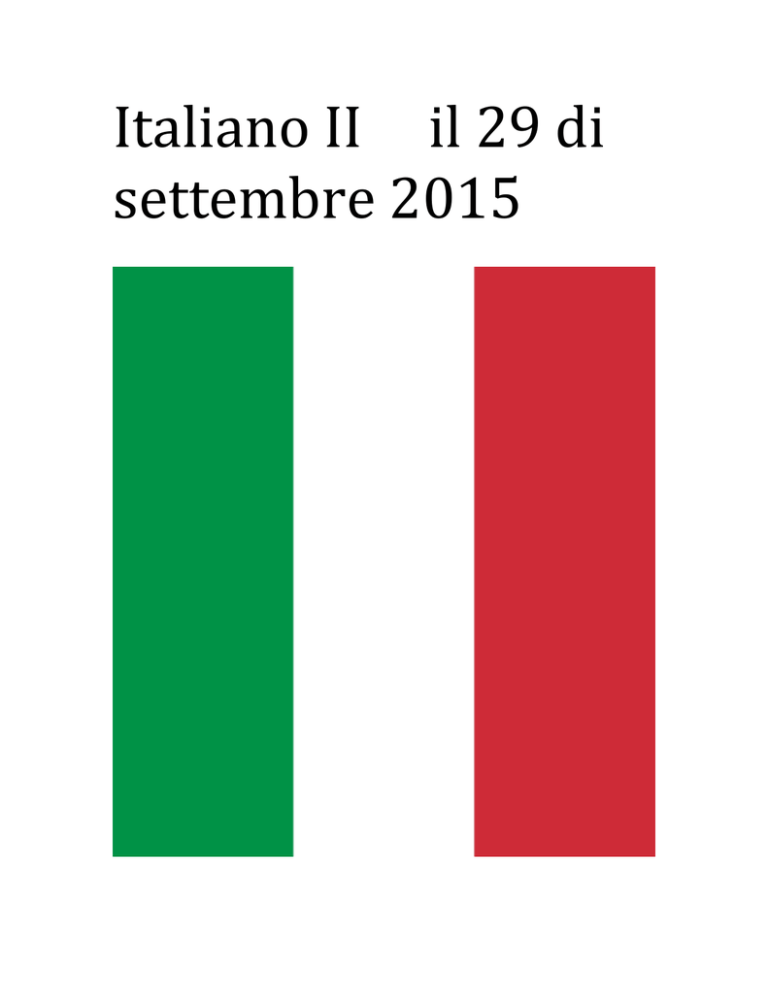
Italiano II il 29 di settembre 2015 Aggettivi Adjectives in Italian: Form and Agreement An adjective is a word that qualifies a noun; for example, a good boy. In Italian an adjective agrees in gender and number with the noun it modifies. In Italian there are two groups of adjectives: those ending in -o and those ending in -e. Adjectives ending in -o in the masculine have four forms: Singola re Plurale Maschile -o Femminile -a -i il libro italiano i libri italiani il primo -e la signora italiana le signore italiane la mensa giorno i primi giorni universitaria le mense universitarie If an adjective ends in -io, the o is dropped to form the plural. l'abito vecchio (the old suit) gli abiti vecchi (the old suits) il ragazzo serio (the serious boys) i ragazzi seri (the serious boys) Uli è tedesco. (Uli is German.) Adriana è italiana. (Adriana is Italian.) Roberto e Daniele sono americani. (Robert and Daniel are American.) Svetlana e Natalia sono russe. (Svetlana and Natalia are Russian.) Adjectives ending in -e are the same for the masculine and the feminine singular. In the plural, the -e changes to -i. il ragazzo inglese (the English boy) la ragazza inglese (the English girl) i ragazzi inglesi (the English boys) le ragazze inglesi (the English girls) An adjective modifying two nouns of different gender is masculine. i padri e le madre italiani (Italian fathers and mothers) Una Pizza Grande o Una Grande Pizza? Position of Adjectives Workbook Exercises About This Topic 1. Adjectives generally follow the noun. È una lingua difficile. (It is a difficult language.) Marina è una ragazza generosa. Marina is a generous girl.) Note that adjectives of colors that derive from nouns are invariable. Non trovo il maglione rosa. (I can't find the pink sweater.) The adjective blu (blue, navy), which is monosyllabic, is also invariable. Porto la giacca e i pantaloni blu in lavanderia. (I'm taking the blue coat and pants to the laundry.) 2. Certain common adjectives, however, generally come before the noun. Here are the most common: bello (beautiful) bravo (good, able) brutto (ugly) buono (good) caro (dear) cattivo (bad) giovane (young) grande (large; great) lungo (long) nuovo (new) piccolo (small, little) stesso (same) vecchio (old) vero (true) Anna è una cara amica. (Anna is a dear friend.) Gino è un bravo dottore. (Gino is a good doctor.) È un brutt'affare. (It's a bad situation.) But even these adjectives must follow the noun for emphasis or contrast, and when modified by an adverb. Oggi non porta l'abito vecchio, porta un abito nuovo. Today he is not wearing the old suit, he is wearing a new suit.) Abitano iu una casa molto piccola. (They live in a very small house.) Italian Language Lessons Possessive adjectives are those that indicate possession or ownership. They correspond to the English "my," "your," "his," "her," "its," "our," and "their." The Italian possessive adjectives are also preceded by definite articles and agree in gender and number with the noun possessed, not with the possessor. The table below provides a chart of possessive adjectives (aggettivi possessivi) in Italian. ITALIAN POSSESSIVE ADJECTIVES ENGLIS MASCULINE FEMININE MASCULINE H SINGULAR SINGULAR PLURAL my il mio la mia i miei your (of il tuo la tua i tuoi tu) your (of il Suo la Sua i Suoi Lei) his, her, il suo la sua i suoi its our il nostro la nostra i nostri your (of il vostro la vostra i vostri voi) your (of il Loro la Loro i Loro Loro) their il loro la loro i loro As a rule, the Italian possessive adjectives are preceded by definite articles: la mia camicia (my shirt) il nostro amico (our friend) i vostro vicini (your neighbor) i suoi libri (his/her books) One exception is made for idiomatic phrases such as these: a casa mia (my house) ècolpa sua (it's his/her fault) è merito tuo (it's your merit) piacere mio (my pleasure) Question words! Che cosa fai? What are you doing? Cosa hai detto? What did you say? Chi? FEMININE PLURAL le mie le tue le Sue le sue le nostre le vostre le Loro le loro CHI? The word chi means who. It can be used to ask and answer question about people. Chi hai incontrato? Who did you meet? chi riceve gli ospiti host (the one who receives guests) Dove? The word dove is used to ask where questions. Also, one interesting thing to note is that for questions of "how far?", Italians ask fin dove? or "ending where?". Di dove sei? Where are you from? Fin dove andrai? How far will you go? Quando? The Italian word quando means when. It asks and answers "when" questions. When paired with da (from), it can be used to form the present perfect tense. Quando torni? When will you return? Da quando sei qui? How long have you been here? Perché? The word perchè means both why and because. Sono in ritardo perché avevo dimenticato di mettere la sveglia. I an late because I forgot to set my alarm clock. Dimme perchè. Tell me why. Come? The word come means both how and like. It is capable of both asking and answering "how" questions. Come è vestido lui? How is he dressed? È vestido come un poliziotto. He is dressed like a policeman. It can also be used in the phrase come mai to ask "why" questions (how come). Come mai non sei venuto alla festa? Why didn't you come to the party? Quanto? The Italian word quanto translates both as how much and how many, depending on its ending. In English, we have separate words for questions about single or plural quantities. In Italian, you just pluralize the question word as you would any other word. Quanto sono grandi i cani? How big are the dogs? Quanto anni hai? How old are you? Quale? The word quale is the equivalent of the English question word "which". Quale preferisci? Which one do you prefer? Quale macchina è la tua? Which car is yours? Meeting people Introducing Yourself in Italian When meeting new people in Italy, you will most likely find yourself asking either ‘tu come ti chiami?’ or ‘Lei come si chiama?’ Both mean ‘what is your name’ but the first version is informal, and can be used with people of the same age or younger, and the second version is formal to be used with people of an older age or in a business / formal situation. Tu means you informal and Lei means you formal. If in doubt, use Lei and you may be invited to use Tu with the expression ‘Diamoci del tu?’ (Shall we use the informal with each other?) Male or Female? Gender confusing names If asking the name of a male, you may be surprised to hear them answer Andrea or Nicola as these are female names in the UK and US. The pronunciation in Italian is different, however, with the stress on the middle syllable, rather than the first one as it is in English. These are typical male names in Italy, along with others which can be gender confusing to non-Italians such as Gianmaria, Luca, Rosario and Toni (short for Antonio). Typical expressions There are some typical expressions we can use in addition to asking someone’s name when we meet them, such as: Ciao - Hello Piacere - Nice to meet you Di dove sei / di dov’è? - Where are you from (informal and formal)? Sono di ... - I am from ... Che lavoro fai / che lavoro fa? What’s your job (informal and formal)? Mi chiamo ... - My name is ... MEETING PEOPLE more here…… Your handshake should be firm, and don't be surprised if your new friend moves in for a cheek kiss or shoulder slap. When greeting friends, cheek kisses on both sides are as common as shaking hands in Italy. Remember, though, if you're even in Russia or places like Lebanon they'll be expecting three kisses, not two. When you introduce yourself tell someone your name, first and last. For "my name is..." you can say "Io mi chiamo..." or "Il mio nome è...". If you have a nickname or preferred to be called by a shortened version of your name let people know up front. Eating and dining are an important part of Italian culture and one of the main way friends connect with one another. If you meet Italians during your vacation, don't be surprised if you're invited for a long, lazy dinner where conversation and laughter is shared over some good food. What better way to bond and unwind? Here is an example of a conversation that may occur between two people who have just met. The scene is a private home in Naples... YOU: "Ciao, mi chiamo Carlo, Carletto per gli amici, piacere di conoscerti. Come ti chiami?" = "Hi, I'm Carlo, but my friends call me Carletto. Nice to meet you. What's your name?" NEW FRIEND: "Io mi chiamo Claudia." = "I'm Claudia." Y: "Come va?" = "How are you doing?" or "How are you?" NF: "Io sto bene, grazie." = "I'm great, thanks." Y: "Di dove sei?" = "Where are you from?" NF: "Io sono italiano e vivo a Roma, e tu?" = "I'm Italian and I live in Rome and you?" Y: "Io vengo da Sidney." = "I'm from Sydney." NF: "Sei mai stata in Italia?" = "Have you ever been to Italy before?" Y: "No, questa è la prima volta." = "No, this is the first time." NF: "Prego, accomodati!" = "Please, take a seat!" NF: "Vorresti un caffè o qualcosa altro da bere?" = "Would you like a coffee or something else to drink?" Y: "Si, grazie un caffè." = "Yes, thank you, a coffee." NF: "Ti stai divertendo qui?" = "Are you having a good time here?" Y: "Si certamente." = "Yes, of course." NF: "Cosa hai fatto di bello oggi?" = "What did you do today?" Y: "Oggi sono andata al Maschio Angioino e ho fatto delle belle foto." = "Today I went to the Maschio Angioino and I took some beautiful pictures." NF: "Napoli è una bella città, e penso che valga la pena vederla una volta nella vita." = "Naples is a amazing city, I think it's worth seeing it once in a lifetime." Y: "Non molto tempo fa ho pensato a questo viaggio in Italia alla scoperta del paese natio di mio nonno." = "Not too long ago I decided to make this trip to explore the country where my grandfather was born." NF: "Che bella idea! Ricercare le tue radici è interessante. Dove vuoi andare precisamente?" = "What a great idea! Discovering your roots is very interesting. Where would you like to go, exactly?" Y: "Mio nonno era di Caserta, e domani vado là." = "My grandfather was born in Caserta and tomorrow I'm going there." NF: "Dal momento che non conosci bene la strada, posso procurarti una cartina." = "Given that you're not familiar with the area I can get you a map." Y: "Grazie, molto gentile." = "Thank you, that's very kind of you." NF: "Ad ogni modo se vuoi stare qui a lungo, mi piacerebbe farti fare un giro qui attorno." = "By the way, if you want to stay here longer, I would love to show you around." Y: "Grazie, sarebbe bello!" = "Thanks, that would be great!" NF: "Allora, fa' buon viaggio!" = "Well, then, have a great trip!" Y: Grazie per la tua ospitalità = "Thanks for your hospitality." This is only an example about what can be talked about when you meet someone Nouns and articles in Italian Italian Definite Article In English the definite article (l'articolo determinativo) has only one form: the. In Italian, l’articolo determinativo has different forms according to the gender, number, and first letter of the noun or adjective it precedes. i ragazzi e le ragazze (the boys and girls) il quaderno e la penna (the notebook and pen) Here are some rules for using definite articles: 1. Lo (pl. gli) is used before masculine nouns beginning with s + consonant or z. 2. Il (pl. i) is used before masculine nouns beginning with all other consonants. 3. L’ (pl. gli) is used before masculine nouns beginning with a vowel. 4. La (pl. le) is used before feminine nouns beginning with any consonant. 5. L’ (pl. le) is used before feminine nouns beginning with a vowel. The article agrees in gender and number with the noun it modifies and is repeated before each noun. la Coca–Cola e l’aranciata (the Coke and orangeade) gli italiani e i giapponesi (the Italians and the Japanese) le zie e gli zii (the aunts and uncles) The first letter of the word immediately following the article determines the article’s form. Compare the following: il giorno (the day) l’altro giorno (the other day) lo zio (the uncle) il vecchio zio (the old uncle) i ragazzi (the boys) gli stessi ragazzi (the same boys) l’amica (the girlfriend) la nuova amica (the new girlfriend) In Italian, the definite article must always be used before the name of a language, except when the verbs parlare (to speak) or studiare (to study) directly precede the name of the language; in those cases, the use of the article is optional. Studio l’italiano. (I study Italian.) Parlo italiano. (I speak Italian.) Parlo bene l’italiano. (I speak Italian well.) The definite article is used before the days of the week to indicate a repeated, habitual activity. Domenica studio. (I’m studying on Sunday.) Marco non studia mai la domenica. (Marco never studies on Sunday) The Italian indefinite article (l'articolo indeterminativo) corresponds to English a/an and is used with singular nouns. It also corresponds to the number one. INDEFINITE ARTICLES FEMMINILE MASCHILE uno zio (uncle) una zia (aunt) un cugino (cousin, m.) una cugina (cousin, f.) un amico (friend, m.) un’amica (friend, f.) Uno is used for masculine words beginning with z or s + consonant; un is used for all other masculine words. Una is used for feminine words beginning with a consonant; un’ is used for feminine words beginning with a vowel. un treno e una bicicletta un aeroplano e un’automobile uno stadio e una stazione mini Provino per oggi 1. the boy 2. the girl 3. a bus 4. a book 5. a house 6. a pen 7. a notebook 8. a door 9. hello hi bye 10. good night
